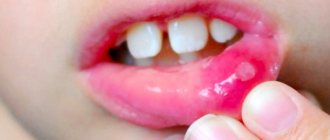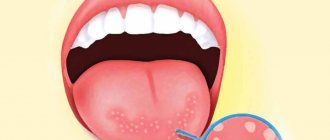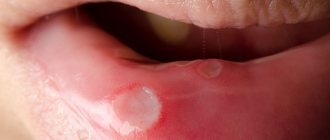- Symptoms
- Causes
- Treatment
- Drugs
Stomatitis is more often referred to as a disease of kindergarten or primary school age: it is an infectious inflammation that is transmitted through shared toys, by contact or by airborne droplets.
But the disease can also occur in a very young child. Parents detect stomatitis at the moment when the child opens his mouth while crying or by characteristic rashes that often appear in the corners of the lips and even on the chin1. If your baby shows signs of stomatitis, do not rush to use homemade ointments and untested remedies - immediately take your baby to the pediatrician. Stomatitis is an infection, and due to the imperfection of the immune system, weakened immunity, it can spread to the ENT organs, liver, kidneys and other organs2.
Causes
Herpetic stomatitis, or as it is also called aphthous stomatitis, is dangerous, first of all, for young children. It is a serious viral disease, which, in addition to damaging the oral mucosa, causes general intoxication of the body and provokes malfunctions of the nervous, immune, and reticuloendothelial systems.
Herpes, which is the causative agent of the disease, may not make itself felt for a long time, although infection usually occurs in early childhood.
When the baby’s immunity is weakened, the herpes virus is activated and begins to multiply, causing an increase in temperature, enlargement of the submandibular lymph nodes, acute inflammation of the mucous membrane, and the formation of bleeding and painful ulcers on its surface.
Main reasons:
- decreased baby's immunity;
- previous infectious diseases;
- lack of vitamins;
- insufficient oral hygiene;
- direct contact with patients with herpes stomatitis.
Infants are more likely to become infected with the herpes virus during childbirth, provided the mother has a herpes infection. In children under one year old and school-age children, the virus is activated against the background of an organism weakened by disease and vitamin deficiency.
Causes of stomatitis in infants
The main cause of stomatitis in infants is weakness of local and general immunity. A newborn baby can be called “sterile”: neither bacteria nor viruses are unfamiliar to its immune system. Therefore, even minor damage to the mucosa can become an entry point for infection. And the low activity of protective mechanisms leads to the active reproduction of viruses, microbes and the appearance of inflammation of oral tissues.
The following can also contribute to the development of stomatitis in a child:
- Intrauterine infections
- Birth injuries
- Infecting a child with infectious diseases during childbirth
- Lack of vitamins and microelements
- Taking antibiotics, hormones, sulfa drugs
- Congenital malformations5
Children in the first year of life often develop traumatic stomatitis. Its cause is damage to the gums and tongue from the sharp edges of toys or trauma to the mucous membrane that occurs due to a strong “hobby” with teethers. Infection immediately penetrates into the resulting wounds, causing inflammation. Therefore, it is very important to ensure that your baby’s toys are safe and clean: rattles and teethers should be washed from time to time in hot water and baby soap6.
Main symptoms and signs of the disease
Acute herpetic stomatitis in children develops gradually and is preceded by an incubation period lasting from two days to 3 weeks.
Early symptoms of the disease are:
- burning in the mouth;
- increased salivation;
- headache, nausea, general weakness;
- increased body temperature;
- enlargement of the submandibular lymph nodes;
- the appearance of bad breath.
«
If the parents do not respond to the first signs, after a few days the mucous membrane becomes covered with multiple rashes. Small painful blisters itch, respond with acute pain to the touch, and when they rupture, a cloudy liquid flows out of them. The rash appears on the baby’s gums, cheeks, tongue, lips, and wings of the nose.
Herpes stomatitis can affect not only a school-age child, but also an infant.
The mild form of the disease can be easily treated at home; in moderate and severe forms, hospitalization of the small patient is indicated.
Kinds
Today, 8 types of stomatitis can be diagnosed:
- bacterial;
- aphthous - manifests itself when immunity decreases due to gastrointestinal diseases and anemia;
- herpetic – occurs due to the herpes virus;
- viral;
- angular;
- allergic – a reaction to an allergen entering the child’s body;
- traumatic - the cause may be an accidental bite of the lip with teeth or scratches on the gum;
- fungal – infection of the oral cavity by fungi of the genus Candida.
All types of stomatitis can occur in childhood. However, from birth to 3 years, children are especially susceptible to aphthous, candidal, herpetic and allergic types. During the period of active growth of baby teeth, traumatic stomatitis often appears, caused by rupture of the soft tissue of the gums.
Note! Stomatitis does not always occur on its own. Quite often, rashes in the mouth are a sign of other diseases, so before treatment it is necessary to carry out a series of diagnostic measures to discover the exact cause.
Symptoms
The classic clinical picture for diagnosing stomatitis includes the following symptoms:
- swelling of the mucous membrane;
- the appearance of a white or yellowish coating;
- bad breath;
- dryness or excessive salivation;
- enlarged lymph nodes and increased temperature.
Stomatitis in children has similar and different symptoms. Each type of disease has its own differences in manifestations.
With allergic stomatitis, minor ulcerative lesions appear on the palate, gums, cheeks, and lips. They pass as soon as the irritant can be identified and removed. With aphthous, even one spot with a diameter of up to 1 cm may appear in the mouth. Its outer part is covered with a film, the ulcer is yellow, and its edges are inflamed. If stomatitis is herpetic, then the mucous membrane is affected by numerous rashes that merge into one large wound. These are blisters with clear liquid and are extremely painful. Often the herpes virus causes a deterioration in the general condition of the child’s body, accompanied by body aches and high fever.
The most common type of stomatitis in a child’s mouth is candidiasis. Its common name is thrush. 9 out of 10 parents have encountered this phenomenon at least once. It is characterized by the appearance of a white cheesy coating on the tongue, gums, and cheeks of the baby. It is often observed after completing a course of antibacterial therapy or as a consequence of infection of the mother’s nipples by Candida fungus. Candidiasis can also be caused by poor hygiene.
On a note! Regardless of the type of stomatitis, its treatment should be comprehensive and begin immediately after the first signs of damage to the oral cavity are detected!
Treatment options
How to cure stomatitis in a child? It’s worth noting right away that you can’t prescribe medications to your baby yourself. Only the pediatrician makes a diagnosis and makes recommendations for therapy. Attempts to overcome the disease on your own can lead to a worsening of the little patient’s condition. To determine the causative agent of the inflammatory process, a scraping is made and a virological study is carried out.
For stomatitis in children, what treatment will be most effective? Only those therapeutic measures will help that will affect the disease comprehensively, eliminating both the cause and external manifestations.
Medicines
When an accurate diagnosis is established, dentists prescribe medications for the treatment of stomatitis in children. They are conventionally divided into symptomatic and special.
The purpose of the first is to eliminate the symptoms that accompany the disease. For this purpose the following is prescribed:
- vitamin complexes to strengthen the body;
- antiviral drugs that fight viruses;
- antipyretic and anti-inflammatory drugs;
- anesthetic gels;
- ointments and solutions for treating the oral cavity.
- need to drink plenty of fluids
- gentle diet (exclude sour, salty, spicy)
Candidal stomatitis is treated with special pharmaceuticals that contain substances that kill the fungus. Creams suitable for internal use are prescribed. If an allergic type is detected, the pediatrician will add antihistamine drops or tablets to the general list. If the rash is caused by the herpes virus, you cannot do without taking antiviral drugs, as well as local treatment of the mucous membranes with antiherpetic ointment.
Attention! The entire oral cavity needs to be treated, since pathogens are found everywhere on the mucous membrane. They are not visible to the naked eye, but if they remain in the mouth, they will continue to spread and the treatment will be delayed.
Folk remedies
Have you noticed stomatitis in a child and don’t know how to treat it? Drug therapy can be supplemented with the use of traditional medicine. Compositions prepared from natural ingredients are used to treat stomatitis in children over 2 years of age.
The following formulations are suitable for treating mouth ulcers.
Soda and salt
0.5 tsp each Dissolve the components in warm water. Rinse your mouth with the solution 3-4 times a day after meals. Baking soda relieves inflammation and disinfects well. The same composition, only diluted with water to a mushy consistency, can be used to clean off plaque from fungal stomatitis using a finger wrapped in gauze.
Honey and aloe
The leaf of the plant is ground to a puree, and the same amount of natural honey is added to it. Apply to affected areas three times a day.
Chamomile with honey
Dried flowers are brewed in the proportion of 1 tbsp. for 250 ml of boiling water. Add 2 tsp to the cooled broth. honey Rinse your mouth with warm liquid 2-3 times a day.
Rinses can be prepared from other ingredients:
- sage;
- rosehip;
- St. John's wort;
- oak bark;
- flaxseeds;
- yarrow;
- calendula;
- propolis tinctures.
Lotions of essential oils help a lot.
Important! Folk remedies can only be used after consulting a pediatrician!
How to prevent stomatitis
To reduce the risk of getting an infection in your mouth, you should:
- regularly wash toys, hands, pacifiers, bottles;
- carry out wet cleaning and ventilate the room where the baby spends his leisure time;
- strengthen the immune system: strengthen the child, give vitamins, maintain proper sleep and wakefulness;
- provide a balanced diet;
- fight the bad habit of biting nails or other objects (pencils, pens, rulers);
- Make an appointment with the dentist twice a year for a routine examination.
Any disease should be treated in a timely manner, otherwise negative consequences cannot be avoided. Carefully examine the child’s oral cavity at the first complaints. When stomatitis occurs in infants, the first symptoms include behavioral changes, crying, and refusal of the breast or bottle. Children aged 1 year and older will be able to independently point out to their parents the source of discomfort. Get treated promptly and be healthy!
Classification and diagnosis
Herpetic stomatitis is classified both according to the severity of the disease and the characteristics of its course.
According to the characteristics of the course, acute and chronic (recurrent) forms are distinguished. Acute stomatitis is characterized by a sudden onset, pronounced symptoms, and rapid development. Without proper treatment, it quickly becomes chronic and can drag on for years, periodically exacerbating.
Based on the degree of severity, there are mild, moderate, and severe forms.
In mild forms, the following are noted:
- slight increase in body temperature;
- redness, swelling, inflammation of the gums;
- swollen lymph nodes;
- a small number of painful ulcers.
The average degree is characterized by:
- significant increase in body temperature;
- general weakness, nausea, headache;
- inflammation of the oral mucosa;
- the appearance of a blistering rash on the inner surface of the cheeks, gums, tongue, and around the mouth.
The severe form causes:
- temperature rise to a critical level;
- lymphadenitis of the cervical, submandibular lymph nodes;
- a sharp disturbance in general well-being;
- the appearance of severe muscle pain, headache;
- nausea, vomiting;
- multiple rashes that spread to the eyelids, conjunctiva, and perioral area.
Diagnosing the disease is not difficult for an experienced doctor. It is based on an analysis of the main symptoms, the order of clinical manifestations of the disease, the nature, and multiplicity of ulcers.
It is necessary to differentiate herpetic stomatitis from viral stomatitis; for this, in the first few days of the disease, a cytological examination of scrapings from erosions and aphthae should be done.
Types of childhood stomatitis
In dentistry, there are two main forms of stomatitis in children: acute and chronic. According to the nature of the pathology, mild and moderate severity are distinguished. But the main classification is subdivided according to the characteristics of the clinical picture and causative factors.
Candida
The most common form of childhood stomatitis, which can occur even in newborns. The cause is the Candida fungus, which is transmitted to the child as it passes through the birth canal if the mother is diagnosed with vaginal candidiasis. Transmission of the fungus can also occur during kissing, or insufficient nipple hygiene during breastfeeding. Symptoms of candidal stomatitis are characterized by the formation of a cheesy coating on the mucous membrane with ulcers or inflammation hidden underneath it.
Herpetic
The cause of the disease is the herpes virus. Normally, 90% of people have cells of this virus in their bodies in “sleep mode”. With weakened immunity, the herpes virus begins to activate and infect the mucous membranes. Transmission of the virus is also possible from outside. A distinctive sign is a watery rash on the oral mucosa.
Aphthous
Another common form of stomatitis in young children. The cause may be a different type of virus or a bacterial infection. With aphthous stomatitis, small ulcers with a bright red border appear on the child’s mucous membrane. The sores may bleed and cause severe pain.
Traumatic
In case of injury to the oral mucosa, infection may enter the wound. A large amount of moisture and optimal temperature contribute to its active reproduction. The immune system reacts to the pathological process, resulting in inflammation. Traumatic stomatitis is often diagnosed in children under 3 years of age who have the habit of “tasting everything.” The infection can be brought from an object or present inside the oral cavity due to poor hygiene.
Allergic
In rare cases, allergic stomatitis occurs. The cause of an allergy can be medicine, food, hygiene products, etc. Symptoms, as a rule, are not pronounced.
Recurrent
Recurrent stomatitis is also common among children, which can be attributed more to the chronic form of the disease, since it occurs with poor quality treatment and the presence of concomitant diseases that weaken the immune system.
How long does the disease last and how many days is the child contagious?
Depending on the complexity of the form, herpes stomatitis in children lasts from several days to 2-3 weeks. With a mild form, the main symptoms disappear on the third or fourth day, treatment of a moderate form takes one to two weeks. The severe form is the most dangerous; healing lasts for weeks and requires mandatory hospitalization of the baby.
The disease is characterized by a high degree of contagiousness precisely during the period of exacerbation.
The infection is transmitted by airborne droplets (including through kissing), when using shared dishes, cutlery, toys, and hygiene items.
Herpes is contagious and can easily be transferred to healthy parts of your own body.
It is necessary to wash your hands thoroughly after treating the surface affected by the sores with medications to prevent the spread of the virus.
Types of stomatitis and causes of occurrence in children
The causes of stomatitis in children can be different, and they are directly related to the type of disease. In this section, we will look at the main types of stomatitis and their causes in children.
Herpetic viral stomatitis
This type of stomatitis is the most common and common. Sometimes this type of disease is simply called herpetic stomatitis or viral . Typically occurs in children aged 1 to 4 years.
Often infection occurs through airborne droplets. Infection with herpetic viral stomatitis is also possible through children's toys, dishes and other objects. Against the background of weak immunity, the virus enters the body and settles in the most damaged areas of the mucous membrane. Such places can serve, for example, as small wounds that appear after a child bites his lips.
Aphthous (allergic) stomatitis
This type of stomatitis is often also called drug stomatitis , since the main reason for the appearance of this type of disease is allergic reactions to various medications. It is impossible to say exactly which drugs can cause stomatitis; this is an individual predisposition, and can only be accurately determined by visiting a pediatric dentist after all the necessary diagnostics have been carried out. This type of disease occurs infrequently and, most often, in preschool children.
Traumatic stomatitis
As the name implies, this type of disease occurs after mechanical trauma to the child’s oral cavity and the entry of dirt and bacteria into these places.
Injuries can be of a completely different nature. This could be purely a dental problem. For example, due to an incorrect bite, a child may constantly bite his tongue or lips. Other types of mechanical damage to the mucous membrane include burns, for example, from food that is too hot, a pacifier that is too hard, various bad habits (pulling toys into the mouth, chewing a pencil, etc.).
Candidal (fungal) stomatitis
The main cause of candidal stomatitis is Candida fungi. Basically, this type of disease is typical for children under 1 year of age who are breastfed. Particles of mother's milk remaining in the baby's mouth after feeding provide an excellent environment for the development of this type of fungus. For this reason, sometimes this type of stomatitis is called thrush .
Infectious (microbial) stomatitis
The main reason for the appearance of infectious stomatitis in children is a decrease in immunity against the background of diseases such as tonsillitis, sinusitis, pneumonia and other diseases of the nasopharynx. This type of disease occurs in children of both school and preschool age. Infectious stomatitis develops especially often in the autumn-winter period, when the child’s immunity is weakened.
How and with what to treat herpetic stomatitis in children
As Dr. Komarovsky notes, treatment of herpetic stomatitis in children, regardless of age, depends on the severity of the disease, the general condition of the patient’s immune system, and the presence or absence of concomitant diseases.
The main question that interests young parents is which doctor should they contact if they suspect herpetic stomatitis. Both a qualified pediatrician and a dentist can advise the child.
Therapeutic methods include both general and local treatment. Common activities include:
- prescription of antiviral drugs (acyclovir, Zovirax, Herpevir, Virolex);
- taking antipyretic and painkillers (paracetamol, Panadol, Eferalgan, Tylenol);
- prescription of antihistamines (diazolin, claritin, erius, fenistil);
- correction of the immune system (immudon, sodium nucleinate);
- vitamin therapy (vitamin C, ascorutin, multivitamins, B vitamins).
Children of older preschool and school age are recommended to be treated with broad-spectrum antibiotics to avoid possible complications.
For newborns and infants, antibiotic therapy is prescribed only as a last resort, with preference given to local therapy:
- applications of painkillers (solution of lidocaine, trimecaine, pyromecaine);
- treating the baby’s oral cavity with antiseptics (solutions of furatsilin, potassium permanganate, brilliant green, blue);
- Treatment of aphthae with iodine should be avoided, as it causes a burn to the mucous membrane;
- the use of antiviral medications in the form of ointments, lotions, solutions (interferon, acyclovir);
- applying an oil solution of vitamin A, sea buckthorn or rosehip oil, solcoseryl to the mucous membrane of the baby’s mouth).
If the symptoms of the disease do not disappear on the 3-4th day of treatment, but only intensify, the child is indicated for treatment in a hospital setting, otherwise stomatitis will become chronic, from which it is impossible to get rid of it.
Treatment methods
Childhood stomatitis requires an integrated approach to eliminate the symptoms of the disease, the causes that provoked it and the consequences of the pathological process. The general treatment regimen involves local and general therapy, as well as prophylaxis to prevent relapse of the disease.
Local therapy
To relieve pain, eliminate inflammation, block the spread of the affected area and accelerate the recovery of the mucous membrane, topical medications are used. The procedure can be initially carried out in the dentist's office, then parents independently treat the child's oral cavity several times a day.
Treatment for stomatitis may include:
- professional teeth cleaning (depending on the child’s age);
- applying anti-inflammatory drugs to the lesions;
- for a general antiseptic effect, rinsing with a solution containing chlorhexidine or herbal infusions may be recommended;
- For young children, antiseptic treatment is performed by ingesting chamomile decoction or spraying the mucous membrane with a special spray.
It is not recommended to independently select medications for the treatment of children who have signs of stomatitis. Medicines may have contraindications, including those based on age.
Systemic therapy and prevention
If the cause of stomatitis is a herpes virus, infection, allergy or other internal process, then it is impossible to do without systemic exposure. The dentist, after diagnosing and confirming the underlying cause, will prescribe appropriate medications (for example, antibiotics, antivirals, glucocorticosteroids, immunomodulators, etc.).
Stomatitis can become chronic. In this case, with each weakening of the immune system, an exacerbation occurs with the manifestation of symptoms of the disease. In order to prevent pathology, it is recommended to take vitamin and mineral complexes, timely treatment of any diseases and maintenance therapy for concomitant chronic diseases.
With early treatment for stomatitis in children, recovery occurs quickly. The specialists at the Martinka Clinic have extensive experience in treating all forms of childhood stomatitis. If there are signs of the disease, in order to carry out proper and effective treatment, we recommend making an appointment with a qualified dentist by calling 8-800-222-30-14.
Treatment with folk remedies at home
When treating herpes stomatitis in children, it is extremely important to prevent the development of complications and transition to a chronic form. Therefore, all folk remedies are auxiliary in nature and should not replace full treatment.
To strengthen the child's immunity, a decoction of echinacea leaves, ginseng root, and rose hips is well suited.
Rinsing will help relieve itching, burning and pain. For these purposes, you can use decoctions of chamomile flowers, sage, calendula inflorescences, St. John's wort, alder cones, rose petals, and oak bark.
The healing of ulcers and aphthae is facilitated by treating their surface with brilliant green, blue and iodine; they have a drying effect. An alcohol solution of propolis helps well, it relieves the inflammatory process and has an analgesic effect on the oral mucosa. Use with caution to treat small children.
Newborns and infants are recommended to lubricate the inflamed oral mucosa with natural honey. This should be done with extreme caution, since honey is a fairly strong allergen.
Stomatitis - what kind of disease
Childhood stomatitis is an inflammatory dental disease of the oral cavity that affects the mucous membrane. Pathology can appear in any area: the inside of the cheeks, tongue, palate, lips, gums, etc. As a rule, there is no localization of the affected area. The more advanced the disease, the larger the area of inflammation.
Symptoms of stomatitis in children:
- temperature increase;
- swelling of the mucous membrane;
- redness of the inner lining of the mouth;
- pain;
- the formation of papules and then painful ulcers.
The child has a hard time with the pathology: he is capricious, often cries, refuses to eat, and sleeps poorly.
Treatment of stomatitis in young children involves local and systemic therapy aimed at eliminating inflammation or infection, strengthening the immune system and accelerating tissue regeneration.
Possible complications
Primary infection with herpetic stomatitis is highly treatable. Within 7-10 days, with proper treatment, the child can fully recover. Without appropriate drug therapy, the following complications may develop:
- herpetic keratoconjunctivitis (a dangerous herpetic eye infection that leads to blindness);
- dehydration (due to refusal to eat and drink).
To avoid undesirable consequences, it is necessary to consult a doctor at the first symptoms of the disease, strictly adhere to all instructions, give the baby plenty of fluids, monitor oral hygiene, and wash your hands after each treatment of a surface affected by herpes.
Prevention in children
Preventing infection with the herpes virus is extremely difficult, since 90% of the population are carriers of it. It is important to delay infection as much as possible; the younger the child, the more difficult the disease is to tolerate. It is necessary to avoid contact with people who have an acute herpes virus. From infancy, the baby should be taught to use personal hygiene products, not allowed to drink from someone else’s mug after someone else, or to use used spoons, forks, and plates. You should not kiss someone who has a herpetic sore on their lips.
To prevent herpetic stomatitis, you need to do general strengthening of the child’s immune system, systematically give him B vitamins, multivitamin complexes, and carry out hardening procedures.









